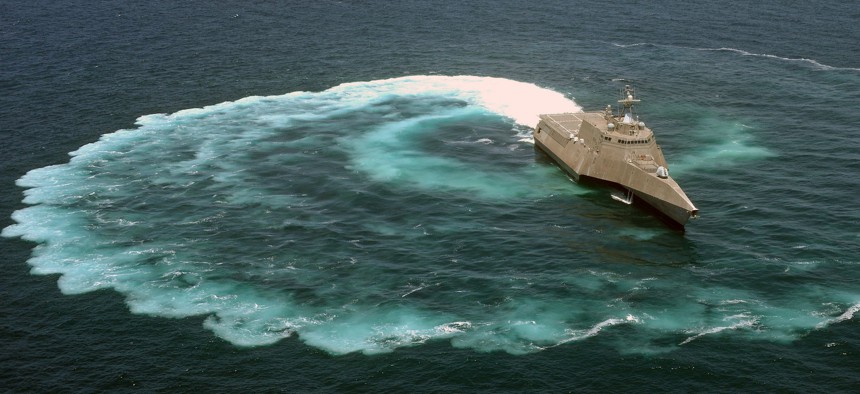
The littoral combat ship USS Independence (LCS 2) demonstrates its maneuvering capabilities in the Pacific Ocean off the coast of San Diego. U.S. Navy / Mass Communication Specialist 2nd Class Daniel M. Young
The Lessons of the Littoral Combat Ship
Analyzing the events of the past 15 years reveals at least four reasons for the current mess.
From its inception, the Littoral Combat Ship, or LCS, has been one of the Navy’s most controversial procurement programs. Questions have been continuously raised about its costs, survivability, lethality, and range limitations.
In 2014, U.S. Defense Secretary Chuck Hagel changed the final 20 of the proposed 55-LCS purchase to fast frigates. The following year, Secretary Ash Carter cancelled 12 of these 20 LCS/FF variants. In February, Sens. John McCain, R-Ariz., and Jack Reid, D-R.I., the chair and ranking member of the Senate Armed Services Committee, criticized the program and concluded that the Navy’s recent history of turning LCS plans into reality is not encouraging.
However, the Navy still wants to buy 40 of the various versions of these small combatants. In fact, in its 2017 budget the service proposes to build two additional ships at a total cost of $1.5 billion, and ultimately plans to spend about $30 billion on the program.
Even if Congress approves funding for the 27th and 28th LCSs in this year’s budget and allows the Navy to buy the entire 40 vessels, we should strive to understand how and why we got into this predicament and what we can learn from it. Analyzing the events of the past 15 years makes it clear that there are at least four reasons for the current mess.
Naval Warfare's Future
• With Maritime Superiority at Stake, US Navy Must Build Partnerships
• Five Possible Futures for the US Navy
• Naval Cooperation is More Crucial Than Ever. Here’s What It Costs.
• The Lessons of the Littoral Combat Ship
• To Confront Russia's Subs, NATO Must Team Up on ASW Aircraft
First, the Navy was too focused on the number of ships rather than their capabilities. Ever since the drawdown of defense spending after Vietnam, the Navy and many of its political supporters became fixated on this metric. Between 1968 and 1977, when the total number of ships dropped from 976 to 464, the Navy adopted a goal of 600 ships, a number that was embraced in the 1980 Republican platform. Although the size of the Navy rose dramatically under President Ronald Reagan, budget constraints forced him to abandon the 600-ship goal (a policy that then-Navy Secretary Jim Webb publicly criticized and as a result was forced to resign), topping off at 566. After the end of the Cold War, the fleet dropped to 279, and the new goal became a 300-ship Navy.
But even under the generous defense budgets that followed 9/11, the Navy could not reach that number by purchasing the normal mix of ships, so it settled on the LCS. For example, the Navy originally planned to purchase 32 Zumwalt-class Destroyers. But because of cost growth, it could afford only three, at a cost of $23 billion. On the other hand, the initial projections for the LCS envisioned buying 52 for less.
Any serious analyst will note that it is not the number of ships that is an appropriate proxy for capability—rather, it is the type. But politically, the number plays well. For example, in an effort to try to get Congress to repeal the Budget Control Act in 2011, then-Secretary of Defense Leon Panetta publicly proclaimed that if the law was not changed, the Navy would be smaller than at any time since before World War I. Republican presidential candidate Mitt Romney made the same point in the 2012 presidential debate.
The second major mistake was assuming that a ship could not only be a minesweeper, but also have anti-submarine warfare, surface combat, and amphibious capabilities. How? The Navy would develop modules that could be placed on the ships rapidly. But rather than being able to rotate the plug-and-fight mission packages in days, it often took weeks or months. By 2012, the Navy admitted that modular changes would be a rare occurrence.
Third, the Navy rushed the ships into production, building the lead ships before their designs were fully developed. The first LCS entered service in November 2008, about seven years after the program was started instead of the normal 10 years. However, the first LCS to be equipped with a mission package did not become operational until late 2014. Had they followed the normal timeline, LCS-1 would have entered the fleet ready to go in 2011, at a lower cost.
Fourth, because of rushing it into production and unrealistic assumptions, the cost of the LCS exploded. For example, the cost of LCS-1 and LCS-2 more than doubled, the largest cost growth by percentage of any Navy program in this decade. By comparison, the cost growth of all its other programs was about 40 percent.
Under current plans and projected budgets, the Navy will purchase all 40 LCSs. It has already purchased 26, and will buy another 14 over the next decade. Given the fact that the Navy shipbuilding budget calls for spending at least 30 percent more in real terms than it received on average in the last 30 years, buying 14 more of these vessels would not be a smart decision.






